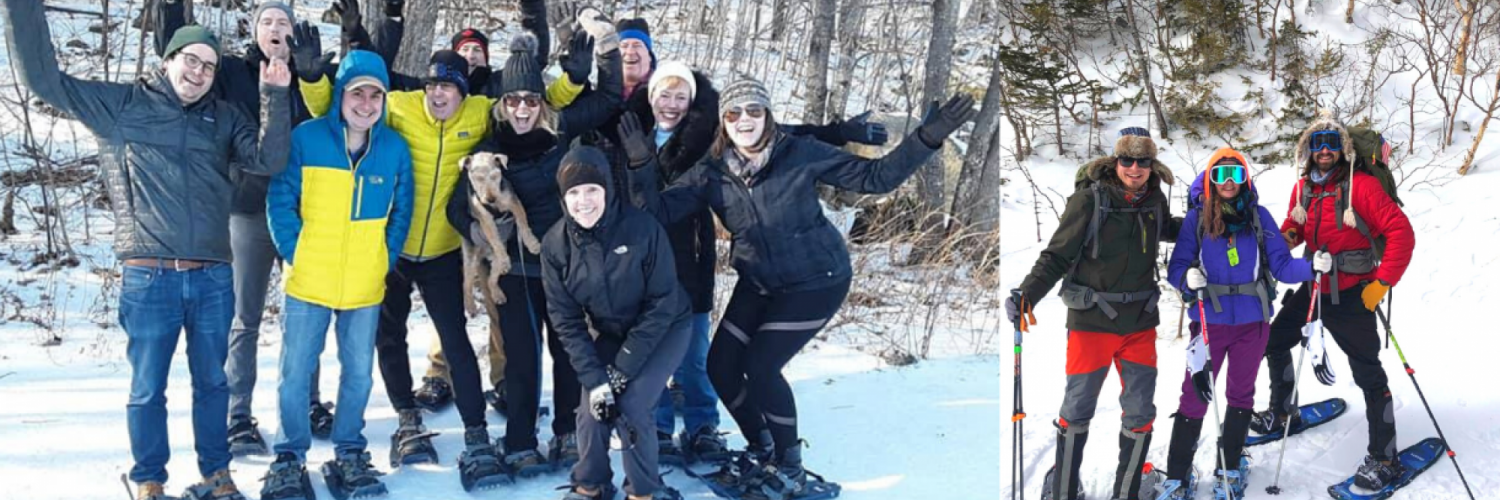
If You Can Walk, You Can Snowshoe
The first time I heard this statement I was standing at the retail counter of the Great Glen Outfitters Shop at Great Glen Trails. It made perfect sense to me. As well as to the guest who was inquiring about what it takes to snowshoe. Snowshoeing is one of the most enjoyable and low impact methods of getting outside in the winter and getting your body moving. Not only are you surrounded by the pristine silence of the woods- you are inevitably- doing good things for your heart and your muscles. The best part- "if you can walk, you can shoe" is absolutely true...so virtually anyone can do it.
So- who thought of strapping those tennis rackets looking devices to their feet and walking on the snow anyway?
It is believed that just about 4,000 years ago- folks in Central Asia came up with the first concept of today's modern snowshoe.
With a growing need to maneuver over snow for travel and hunting, the people of Central Asia modeled the first known snowshoes after animal tracks. Animals that could move quickly and safely over the top of the snow. Think snowshoe hare tracks and bear paws.
In Europe, historians revealed that snowshoes were made from pieces of leather they attached to wide wooden blocks. Ultimately this design led to the invention of the Nordic ski- as tribes moved into what is now Scandinavia. Perhaps more on this in another blog?
Further along in history, when tribes began crossing the Bering Strait and settled in North America, snowshoe designs evolved even more. The tribes of the American Northeast such as the Huron and Algonquin introduced snowshoes to European hunters, trappers, and surveyors. They were at times, very long (up to 7 ft.) and were made from ash trees and untanned rawhide webbing.
However, even though most tribes had a favored type of snowshoe they used, shapes and length varied widely among tribes depending on their location, harshness of winter, and their decided use for the shoes.
The Inuit of the far north used almost round snowshoes, while tribes in the south tended to have longer, narrower snowshoes. Some snowshoes were shorter for maneuverability in the woods. Think Tundra versus the Boreal Forest of the White Mountains.
Present Day- You have decided that you want to go snowshoeing. Today- there are a lot of options. Technological advances have made it possible to choose from just as many snowshoes as you would regular shoes. Excursion, running, touring, racing. You name it- there's a snowshoe for it.
All you need to do is decide what type of "shoeing" you are up for!
If you're like me, a gentle walk in the woods is my usual go-to. So, I use a simple Tubbs Wilderness snowshoe. It's stable, not too big, and easy to walk in. I find it is perfectly suited for strolling down a groomed trail, like at Great Glen Trails, as well as being quite suitable for those more adventurous walks in the backcountry.
One of the coolest things I have done is take a SnowCoach ride at the Mt. Washington Auto Road and then proceed to snowshoe down from the tour. The Auto Road recommends going all the way to the top- so you can have the full SnowCoach experience, and then choose with your driver's recommendation and expertise, where the best point is for you and your ability to hop out and snowshoe down the Auto Road!
It's a great way to explore the lesser-seen areas of the road- especially in the winter- and because there is SnowCoach traffic- you're not left alone out there and on your own. The drivers always slow down when passing and ask how you're doing.
Come on out and play in the snow! Just make sure you don't forget your shoes!
About the Author: Shannan Budde is the Social Media Director for the Mount Washington Auto Road and Great Glen Trails. She is an avid downhill skier and outdoors enthusiast. Shannan now resides in Eaton, NH with her husband Lauren and her dog, Canaan.


